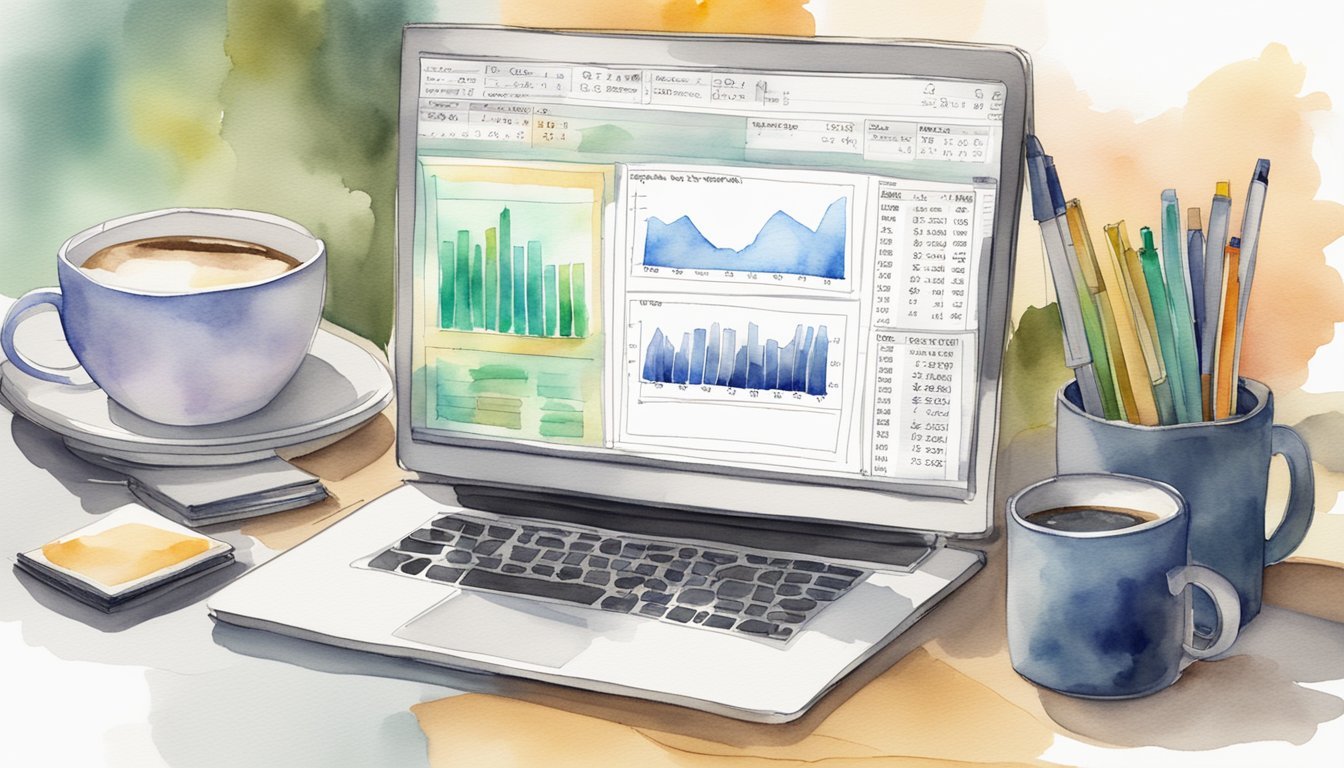Tips for Successful Day Trading: Insider Secrets from the Pros

Day trading can be thrilling, but it requires skill and a solid plan to be successful.
Many beginners jump in without fully understanding the risks and find themselves struggling. So, what do the pros know that the rest of us don’t?

You need to know the right strategies and techniques used by seasoned traders.
Learning from what experienced day traders do can help you avoid common pitfalls and improve your chances of success.
1) Start with a Solid Plan

First things first, before you dive into day trading, you need a solid plan.
A well-structured plan helps you stay focused and make smart decisions in the heat of the moment.
Your trading plan should outline your goals.
Are you aiming for small, consistent gains or larger, riskier profits? Knowing your targets gives you direction.
Next, decide how much money you are willing to risk.
This is known as risk management.
Never risk more than you can afford to lose.
Don’t forget to specify your trading strategies.
Will you use technical analysis or focus on market news? Here’s a guide that dives into different strategies.
An economic calendar can be really useful.
It tracks market-moving events so you can plan your trades around them.
Learn more about how to use one here.
It’s also important to test your plan in a practice account.
Backtesting your strategies can show you what works and what doesn’t without risking real money.
Keep a trading journal.
Documenting your trades helps you learn from your mistakes and realize what you did right.
It’s a helpful way to refine your approach over time.
Check out the benefits of a trading journal here.
By starting with a solid plan, you set yourself up for a successful day trading experience.
It might seem like extra work, but it pays off in the long run.
2) Master Technical Analysis

To succeed in day trading, mastering technical analysis is key.
This involves studying charts and patterns to predict future price movements.
One way to do this is by using support and resistance levels.
These levels act as barriers where the price tends to stop and reverse direction.
Next, familiarizing yourself with indicators such as moving averages and the Relative Strength Index (RSI) can help you make better decisions.
These indicators offer insights into whether a stock is overbought or oversold and can signal potential trends.
It’s also important to use multiple time frames.
For instance, you might look at both daily and hourly charts.
This can provide a clearer picture of the stock’s behavior over different periods.
Testing the effectiveness of various indicators before relying on them is crucial.
Take time to back-test strategies using historical data to see how they would have performed in the past.
Combining technical analysis with fundamental analysis can be beneficial.
While technical analysis focuses on price movements and patterns, fundamental analysis looks at a company’s financial health and market value.
Keeping track of your trades in a journal is another habit of successful technical traders.
Write down why you made each trade, what indicators you used, and the outcome.
This helps identify what works and what doesn’t, refining your strategy over time.
Relying on indicators rather than just your gut is essential.
The data-driven approach is more objective and can help remove emotion from your trading decisions.
Focus on stocks with favorable risk-to-reward ratios.
For example, if a stock is trading at $10 with support at $9 and resistance at $15, you can aim for a trade where you risk $1 to gain $5.
This can greatly improve your profitability.
3) Use a Reliable Trading Platform
A good trading platform is important for your day trading success.
It needs to be reliable and fast.
Look for platforms with a good reputation.
Sites like Forbes’s best platforms can help you choose.
Some platforms offer tools, charts, and news updates.
These features can be really helpful.
Make sure the platform is easy to use.
You don’t want to waste time figuring out how it works.
Check for fees.
Some platforms have hidden costs that can eat into your profits.
Customer support is key.
Make sure you can get help when you need it.
A good platform should keep your data safe.
Look for platforms with strong security measures.
Try out the demo version.
This lets you get a feel for the platform before committing.
Lastly, make sure the platform fits your trading style.
Some are better for beginners, while others cater to experienced traders.
4) Stay Updated with Market News
Day trading thrives on the latest information.
Staying updated with market news is one of the most important things you can do.
News events can drastically change market conditions.
Follow major financial news websites and use news aggregators.
These tools help you get real-time updates on economic events.
It’s crucial to know what’s happening in the market at any given moment.
Pay attention to announcements from the Federal Reserve.
Interest rate changes or economic forecasts can impact the stock market.
Prepare in advance by knowing when these updates are scheduled.
Listening to financial podcasts and reading blogs can also help you stay informed.
Many experienced traders share tips and insights that can be very useful, especially when you’re just starting out.
Use financial calendars to keep track of important dates.
Economic reports, earnings announcements, and other events can influence market movements.
Being aware of these events gives you an edge in your trading.
Consider subscribing to newsletters from reputable traders.
They often share valuable insights and timely information.
This can help you make better decisions quickly.
Keeping a close eye on social media can also be beneficial.
Twitter, for example, is a platform where many traders and analysts share real-time updates and opinions.
Just make sure to follow credible sources.
Stay sharp and always be ready to act on the latest market news.
The more informed you are, the better your day trading decisions will be.
For detailed trading strategies, you can refer to informative guides like this Complete Guide to Day Trading.
5) Set Realistic Goals

Start by setting small, achievable goals.
It’s important to aim for steady growth rather than quick riches.
This way, you avoid the pressure of having to make large profits right away.
Unrealistic goals can lead to reckless decision-making.
When you expect too much too soon, you might take unnecessary risks.
This can result in big losses that could have been avoided.
Focus on creating a consistent track record.
Look at your progress over time instead of trying to hit a big win every day.
Tracking your performance over weeks and months can give you a clearer picture of your success.
Remember to evaluate and adjust your goals regularly.
The market changes and so should your strategies.
By being flexible and realistic, you’ll improve your chances of long-term success.
Staying realistic helps manage stress.
Day trading can be intense, and setting achievable goals can make it more manageable.
Less stress means better decision-making and more enjoyment in the process.
It’s also essential to know your limits.
Only risk the amount of money you can afford to lose.
This prevents financial strain and keeps your trading activities sustainable over the long haul.
For more detailed strategies on setting and sticking to goals, check out this Complete Guide to Day Trading.
Keep learning and adapting.
The more experience you gain, the better you’ll get at setting and reaching realistic goals.
This mindset helps your trading skills grow over time.
6) Control Your Emotions
In day trading, emotions can mess with your judgment.
Fear, greed, and anxiety often lead to irrational decisions.
Avoid trading when you’re angry.
Anger clouds your thinking.
It’s better to wait until you are calm and collected.
Use a trading journal.
This helps you stay on track and see patterns in your decisions.
Lowering your trade size can reduce emotional stress.
Smaller trades make fluctuations less frightening, making it easier to think clearly.
Stick to a solid trading plan.
A well-thought-out strategy helps you stay disciplined and make logical choices, not emotional ones.
Check out DayTrading.com for more ways to control emotions in trading.
Consider practicing emotional detachment.
Treat each trade as just a number, not a personal win or loss.
Take breaks.
If you’re not feeling it, step away from the computer.
Returning with a fresh mind can prevent emotional trading.
For more tips, see TraderSync.
Focus on continuous learning.
The more you know, the more confident and less emotionally driven you’ll be.
7) Diversify Your Portfolio
Diversifying your portfolio is key in day trading.
Don’t put all your eggs in one basket.
Spread your investments across various assets.
Consider mixing stocks, bonds, and commodities.
This way, if one market dips, others might hold or rise, balancing your risks.
Check out this guide on diversified investment portfolios for more ideas.
Don’t forget about foreign exchange.
FX trading can offer unique opportunities.
Including it in your portfolio could provide another layer of protection.
Stay informed and regularly review your investments.
Keeping an eye on market trends can help you adjust your strategy.
Diversification isn’t a one-time task; it needs constant attention.
Remember, different types of assets can behave differently in various market conditions.
By diversifying, you can leverage the strengths of each, reducing potential losses.
Lastly, balancing your investments based on your age can provide a good starting point.
Younger traders might take more risks, while older traders might focus on more stable assets.
For more tips on diversification, check out this guide on how to diversify.
Stay proactive and make adjustments as needed to keep your portfolio strong and balanced.
8) Keep a Trading Journal
A trading journal is your best friend in day trading.
It’s where you record every trade you make.
Being consistent is key.
Write down every trade, even the small ones.
This helps you see patterns over time.
Honesty is crucial.
Don’t sugarcoat your trades or make excuses.
Being truthful with yourself helps you learn.
Detail is important.
Note everything about the trade: why you entered, your strategy, the outcome, and what you learned.
This information is valuable for future reference.
An organized journal is easier to review.
Use a spreadsheet or a dedicated trading journal tool.
This keeps your entries neat and searchable.
Setting goals with your journal can also help.
Common goals include recording all trades, improving discipline, and reducing impulsive trades.
Review your journal regularly.
Look for trends in your success and areas needing improvement.
This reflection can lead to personal growth and better performance.
Using a journal is a powerful habit.
It might seem dull at first, but over time, it can be one of the most valuable tools in your trading toolkit.
9) Leverage Stock Screeners

Using stock screeners can really help in day trading.
They filter stocks based on your criteria, saving you tons of time.
You can quickly spot opportunities without manually sifting through thousands of stocks.
Real-time data is essential.
Make sure the stock screener updates constantly.
This will ensure you’re always working with the latest information. Benzinga Pro and TradingView are great examples of tools offering real-time data.
Customization is also important.
Some screeners offer the ability to tweak settings to match your trading strategy.
For example, StockFetcher is known for its customizable features.
You can set specific filters for various stock characteristics, such as price, volume, and technical indicators.
Don’t ignore free options.
Tools like Finviz provide good screening capabilities without costing a dime.
This can be a good starting point if you’re new to day trading or working with a limited budget.
Versatility matters too.
Some screeners offer multiple functions beyond just stock filtering. ChartMill is noted for its versatile features, such as charting and backtesting, which can provide a more comprehensive trading experience.
By leveraging these tools, you can make quicker, more informed decisions and potentially increase your chances of success in day trading.
10) Understand Risk Management
Understanding risk management in day trading is crucial.
It’s about protecting your capital and staying in the game long enough to see profits.
Always set a maximum risk level beforehand to avoid emotional decisions.
Position sizing is another key element.
Only risk a small percentage of your trading capital on any single trade.
This helps you stay afloat even if some trades don’t go your way.
Stop-loss orders are essential.
They automatically sell your position when it reaches a certain loss level.
This limits how much you can lose on a single trade.
Use take-profit levels to lock in gains.
Just like stop-loss orders, take-profit levels sell your position once it hits a pre-determined profit point.
Diversify your trading strategies and assets.
Don’t put all your eggs in one basket.
If one strategy or asset doesn’t perform well, others might.
Monitor market conditions constantly.
Stay updated on news and trends that could impact your trades.
Rapid changes can affect your risk levels.
Regularly review and adjust your strategies.
The market is always evolving, and what works today might not work tomorrow.
Stay flexible.
Manage your emotions during trading.
Fear and greed can lead to poor decisions.
Stick to your trading plan to avoid impulsive moves.
Risk management is an ongoing process.
Continuously educate yourself and fine-tune your approach.
It helps you navigate the challenges of day trading more effectively.
For more detailed strategies, you can check out effective risk management strategies for day trading.
Understanding Market Trends
Knowing how to read market trends is key to making smart trading decisions.
You’ll need to know how to analyze market signals and interpret price movements effectively.
Analyzing Market Signals
Market signals can come from various sources such as news, economic data, or trading volume.
Keeping track of these signals helps you predict market direction.
Pay attention to significant news that affects the economy or specific industries.
This information often results in volatility, presenting trading opportunities.
You can also look at trading volume.
High volume during a price increase indicates strong buying interest.
Conversely, high volume during a price decrease suggests significant selling pressure.
Watch for these signals to help you decide when to enter or exit a trade.
For better accuracy, use technical indicators like moving averages or Relative Strength Index (RSI).
These tools help identify trends and possible reversal points.
Combining these indicators with news analysis improves your chances of understanding market movements correctly.
Interpreting Price Movements
Price movements are directly affected by supply and demand.
Prices rise when demand is greater than supply, and they fall when supply exceeds demand.
Familiarize yourself with candlestick charts as they visually represent price movements and can indicate potential reversals or continuations.
Short-term traders often use support and resistance levels.
Support is a price point where demand is strong enough to prevent the price from falling further.
Resistance is a level where selling pressure prevents the price from rising higher.
Identifying these levels helps you plan your trades effectively.
Make use of chart patterns like head and shoulders, double tops, and triangles.
These patterns can suggest the future direction of price movements.
Staying informed about typical price behavior will aid you in spotting profitable trading opportunities.
Essential Tools for Day Trading
To be a successful day trader, you need more than just strategies.
The right tools are essential to navigate the fast-paced trading environment.
Let’s look at the key tools you need.
Choosing the Right Trading Platform
Your trading platform is your most important tool.
It allows you to buy and sell securities in real-time.
When selecting a platform, consider speed and reliability.
Delays can mean lost opportunities.
Look for platforms with real-time data and minimal downtimes.
Ease of use is crucial too.
A complicated interface can slow you down.
Choose one that’s intuitive and matches your trading style.
Lastly, check for additional features like charting tools, custom alerts, and mobile access.
These can enhance your trading experience and help you stay informed on the go.
Utilizing Technical Indicators
Technical indicators help you analyze market trends and make informed decisions.
They use historical price and volume data to predict future movements.
Common indicators include moving averages, Relative Strength Index (RSI), and Bollinger Bands.
Moving averages smooth out price data to identify trends.
RSI measures the speed and change of price movements, helping you spot overbought or oversold conditions.
Bollinger Bands show volatility and potential price reversal points.
Using a combination of indicators can give you a fuller picture of the market.
Don’t rely on just one.
Learn how they work together to confirm trends and signals.
This way, you can better plan your trades and manage risks effectively.
Managing Risk Effectively

Managing risk is crucial in day trading.
Understanding how to set stop-loss orders and diversify trades can protect your capital and enhance your trading success.
These methods help you limit potential losses and balance your investments across different trades.
Setting Stop-Loss Orders
Stop-loss orders are essential for every day trader.
These orders let you set a specific price at which your trade will automatically sell to prevent further loss.
This helps you control potential losses without having to constantly monitor your trades.
For instance, if you buy a stock at $50, you might set a stop-loss order at $45.
If the stock price falls to $45, the order will sell your shares, capping your losses at $5 per share.
This way, you can avoid significant losses in rapidly changing markets.
Using stop-loss orders ensures that you stick to your risk management plan.
It also helps you emotionally detach from the trade, reducing impulsive decisions during market volatility.
Diversifying Your Trades
Diversification in day trading means spreading your investments across different assets or trading strategies.
This reduces the risk of losing all your capital in a single trade.
When one trade underperforms, others may perform better, balancing your overall results.
To diversify effectively, invest in multiple stocks, sectors, or even trading instruments.
For example, instead of putting all your money in tech stocks, consider buying stocks in various industries like healthcare, energy, or consumer goods.
Be mindful not to over-diversify, as this can dilute your returns.
A balanced approach, where you have varied but manageable investments, works best.
By diversifying, you create a safety net that can help cushion against unexpected market movements.
Frequently Asked Questions
Day trading can be complex and intimidating.
Get answers to some common questions that can help you navigate through the noise and focus on what matters.
How much can you typically make per day with a $10,000 day trading account?
How much you can make depends on your trading skills and strategy.
Some traders make a few hundred dollars a day, while others may see different results.
Remember, gains are not guaranteed, and losses are just as likely.
Can you break down the basics of day trading for a total newbie?
Day trading involves buying and selling financial instruments within the same trading day.
You need a solid plan, mastery of technical analysis, and staying informed with market news.
Start small and gradually increase your trading size as you gain confidence.
What’s considered the most profitable day trading strategy?
The Gap and Go strategy is often rated highly by traders.
It involves finding stocks that have a significant gap up in price during pre-market trading and then buying as they continue to rise.
Are there any golden rules or strategies I should follow when trading?
A few key rules include setting realistic goals, always having a solid trading plan, and using a reliable trading platform.
It’s crucial to keep a cool head and avoid emotional trading, as well as staying updated with market news.
What exactly is the 3-5-7 rule in day trading, and how can it help me?
The 3-5-7 rule helps you manage your trades by setting specific time frames to assess their performance.
After 3 minutes, check if the trade is profitable.
At 5 minutes, decide whether to hold or exit.
At 7 minutes, make a final decision before the market changes.
Got any cool day trading hacks that the pros keep to themselves?
One effective hack is to avoid overtrading; focus on quality over quantity.
Use hotkeys for quick trade execution and always review your trades at the end of the day to learn from your mistakes.
Being disciplined and sticking to your plan is key to long-term success.

